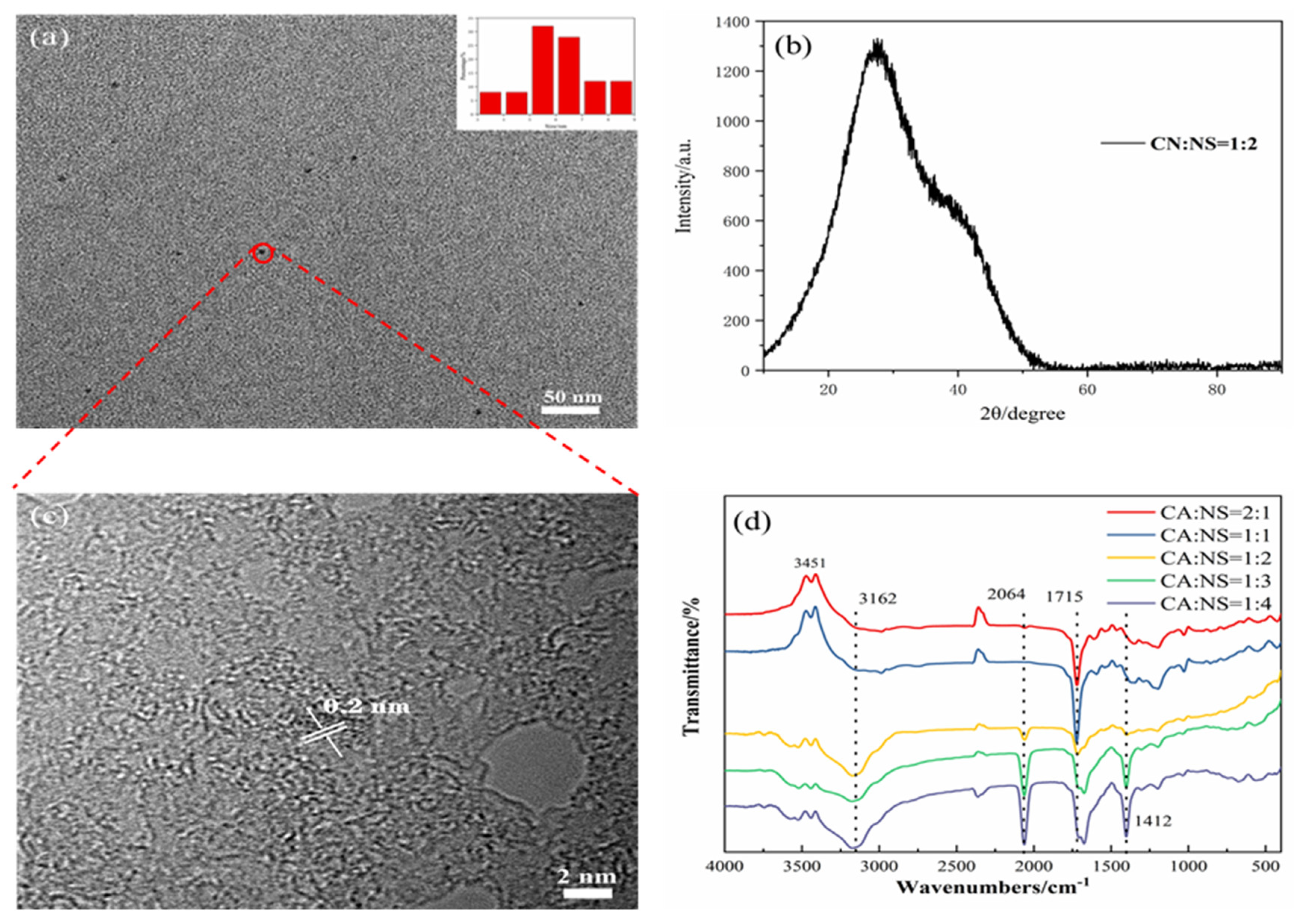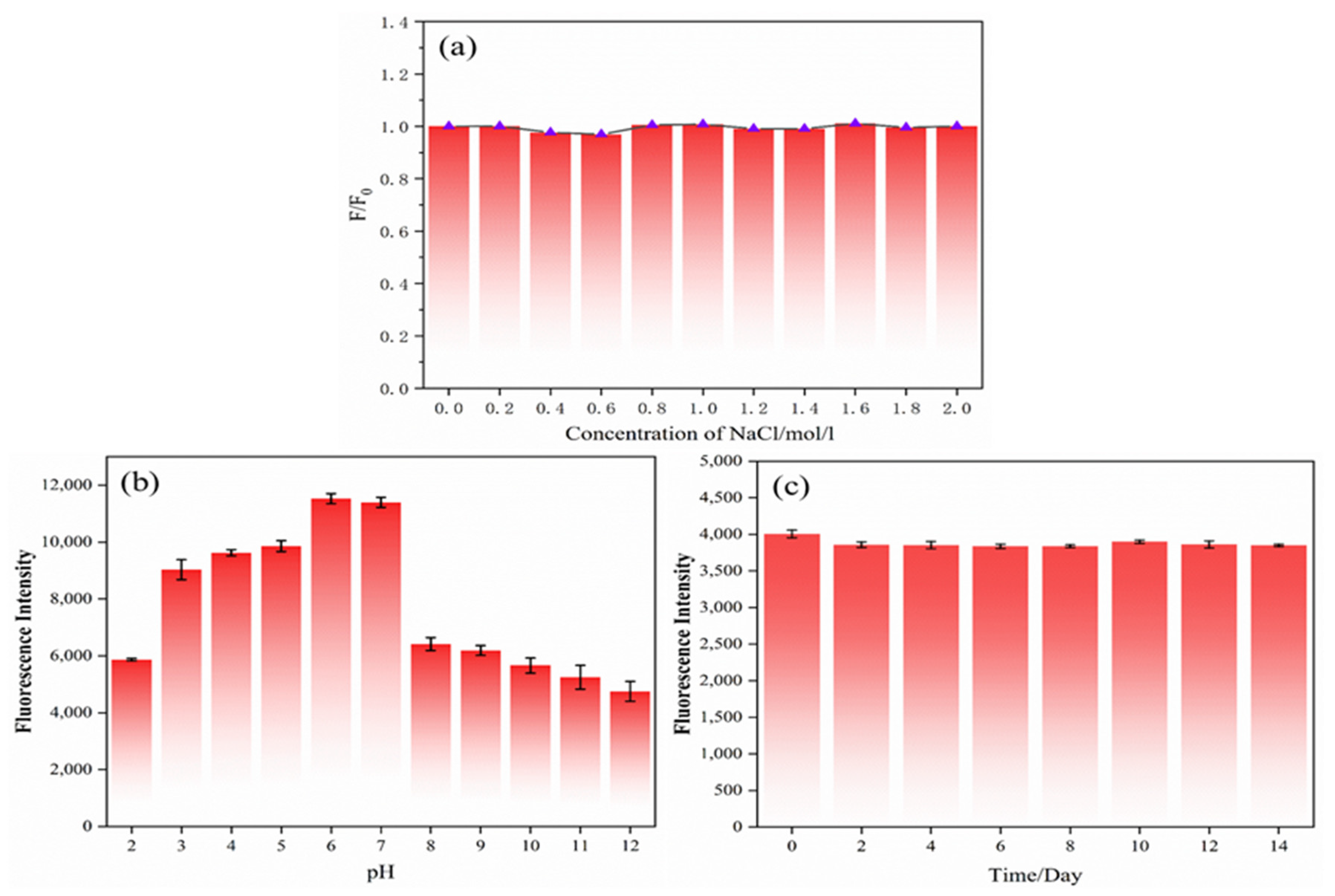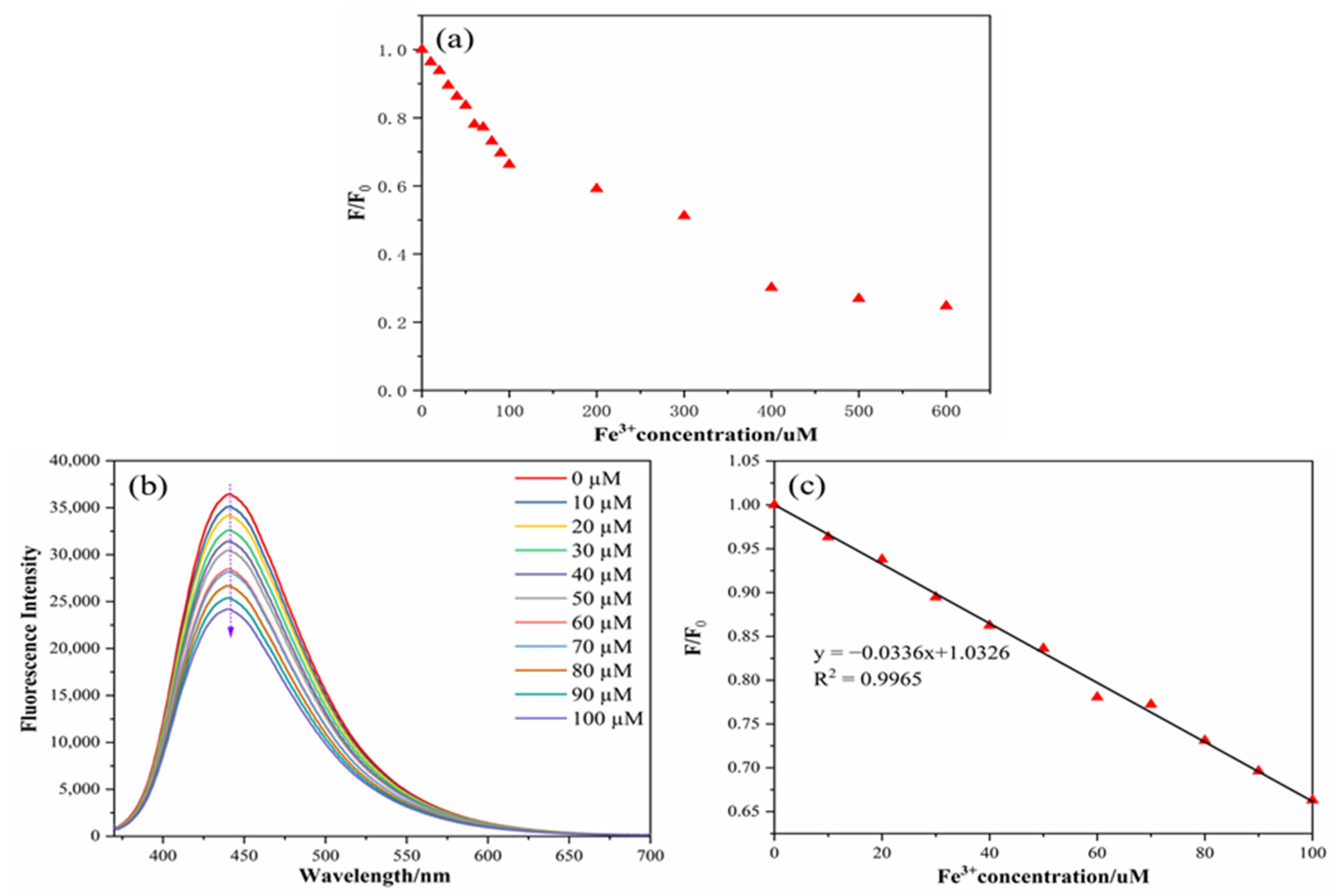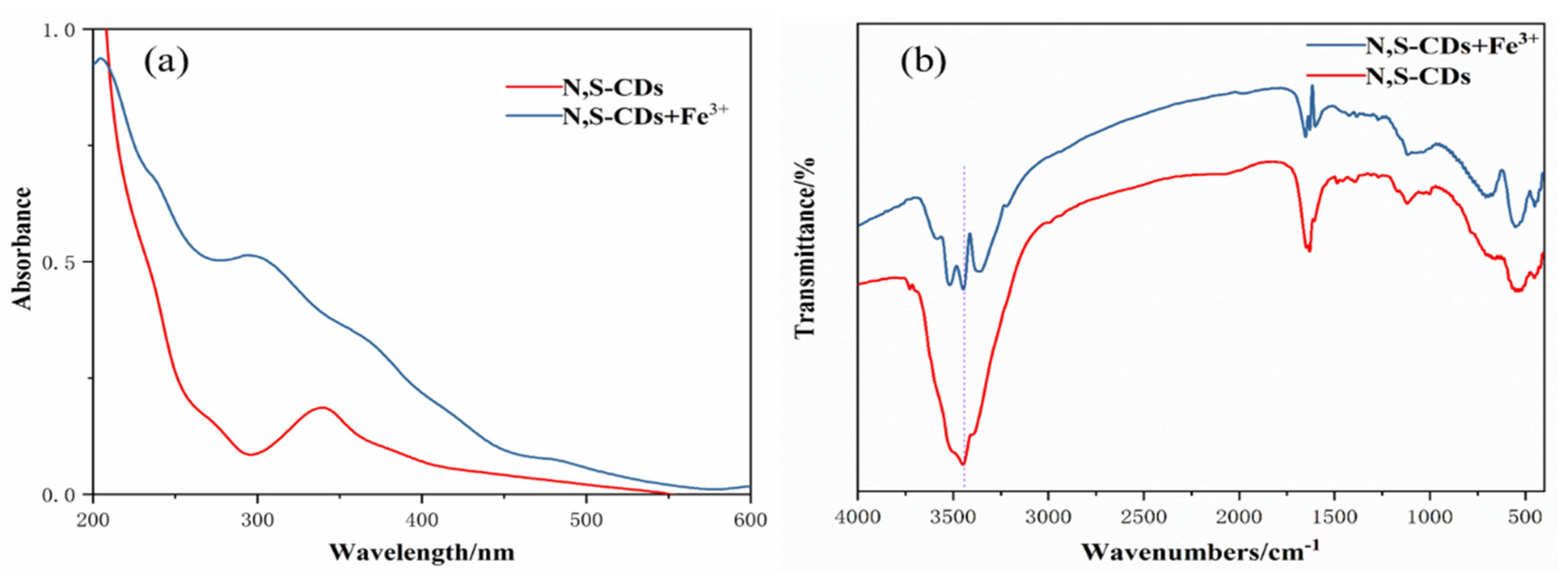Selective Detection of Fe3+ by Nitrogen–Sulfur-Doped Carbon Dots Using Thiourea and Citric Acid
Abstract
:1. Introduction
2. Experimental Section
2.1. Materials
2.2. Instruments
2.3. Preparation of N,S-CDs
2.4. Fluorescence Quantum Yield Determination
2.5. Detection of Fe3+ Ions
2.6. Selective Detection of Metal Ions
2.7. Real Samples Measurement
3. Results and Discussion
3.1. Structure and Characterization of Carbon Dots
3.2. Optical Properties of Carbon Dots
3.3. Fluorescence Quantum Yield of Carbon Dots
3.4. Stability of Carbon Dots
3.5. Metal Ion Selectivity
3.6. Linear Analysis of Carbon Dots on Fe3+
3.7. Real Sample Analysis
4. Conclusions
Author Contributions
Funding
Institutional Review Board Statement
Informed Consent Statement
Data Availability Statement
Conflicts of Interest
References
- Yan, Z.; Hu, L.; You, J. Sensing materials developed and applied for bio-active Fe3+ recognition in water environment. Anal. Methods. 2016, 8, 5738–5754. [Google Scholar] [CrossRef]
- Roth-Walter, F.; Pacios, L.F.; Bianchini, R.; Jensen-Jarolim, E. Linking iron-deficiency with allergy: Role of molecular allergens and the microbiome. Met. Integr. Biometal Sci. 2017, 9, 1676–1692. [Google Scholar] [CrossRef] [Green Version]
- Bischof, H.; Burgstaller, S.; Waldeck-Weiermair, M. Live-Cell Imaging of Physiologically Relevant Metal Ions Using Genetically Encoded FRET-Based Probes. Cells 2019, 8, 492. [Google Scholar] [CrossRef] [PubMed] [Green Version]
- Qi, D.; Chen, L.; HaiJun, W. Electrochemical detection of heavy metal ions in water. Chem. Commun. 2021, 57, 7215–7231. [Google Scholar]
- Malik, L.A.; Bashir, A.; Qureashi, A.; Pandith, A.H. Detection and removal of heavy metal ions: A review. Environ. Chem. Lett. 2019, 17, 1495–1521. [Google Scholar] [CrossRef]
- Rao, K.M.; Raagala, V.; Kasula, N. Fabrication of Polyelectrolyte Membranes of Pectin Graft-Copolymers with PVA and Their Composites with Phosphomolybdic Acid for Drug Delivery, Toxic Metal Ion Removal, and Fuel Cell Applications. Membranes 2021, 11, 792. [Google Scholar]
- Sugumari, V.; Karthikeyan, R.; Remya, R.R. Recent developments in magnetic nanoparticles and nano-composites for wastewater treatment. J. Environ. Chem. Eng. 2021, 7, 106553. [Google Scholar]
- GB 5749–2006; Standards for Drinking Water Quality. National Standards of the People’s Republic of China: Beijing, China, 2006.
- Reddy, D.R.; Dinesh, G.K.; Anandan, S. Sonophotocatalytic treatment of Naphthol Blue Black dye and real textile wastewater using synthesized Fe doped TiO2. Chem. Eng. Process. Process Intensif. 2016, 99, 10–18. [Google Scholar] [CrossRef]
- Shi, D.; Ouyang, Z.; Zhao, Y.; Xiong, J.; Shi, X. Catalytic Reduction of Hexavalent Chromium Using Iron/Palladium Bimetallic Nanoparticle-Assembled Filter Paper. Nanomaterials 2019, 9, 1183. [Google Scholar] [CrossRef] [Green Version]
- Wietstock, P.C.; Kunz, T.; Waterkamp, H.; Methner, F.J. Uptake and Release of Ca, Cu, Fe, Mg, and Zn During Beer Production. J. Am. Soc. Brew. Chemists. 2015, 73, 179–184. [Google Scholar] [CrossRef]
- Deckers, M.; Deforce, D.; Fraiture, M.A.; Roosens, N.H.C. Genetically Modified Micro-Organisms for Industrial Food Enzyme Production: An Overview. Foods 2020, 9, 326. [Google Scholar] [CrossRef] [PubMed] [Green Version]
- Juan, Z.; LiHui, X.; QingNan, L. Metal chelator EGCG attenuates Fe(III)-induced conformational transition of α-synuclein and protects AS-PC12 cells against Fe(III)-induced death. J. Neurochem. 2017, 143, 136–146. [Google Scholar]
- Mittal, S.K.; Kumar, S.; Kaur, N. Enhanced Performance of CNT-doped Imine Based Receptors as Fe(III) Sensor Using Potentiometry and Voltammetry. Electroanalysis 2019, 31, 1229–1237. [Google Scholar] [CrossRef] [Green Version]
- Adolfo, F.R.; Nascimento, P.D.; Leal, G.C. Simultaneous determination of iron and nickel as contaminants in multimineral and multivitamin supplements by solid sampling HR-CS GF AAS. Talanta 2019, 159, 745–751. [Google Scholar] [CrossRef]
- Jalili, R.; Khataee, A.; Rashidi, M.R. Dual-colored carbon dot encapsulated metal-organic framework for ratiometric detection of glutathione. Sens. Actuators B Chem. 2019, 297, 126775. [Google Scholar] [CrossRef]
- Kim, K.W.; Choi, T.Y.; Yong, M.K. Simple synthesis of photoluminescent carbon dots from a marine polysaccharide found in shark cartilage. Electron. J. Biotechnol. 2020, 47, 36–42. [Google Scholar] [CrossRef]
- Thomas, C.W.; Piergiorgio, G.; Anh, N.P. Biomass-Based Carbon Dots: Current Development and Future Perspectives. ACS Nano. 2021, 15, 15471–15501. [Google Scholar]
- Hashemi, N.; Mousazadeh, M.H. Preparation of fluorescent nitrogen-doped carbon dots for highly selective on-off detection of Fe3+ ions in real samples. Opt. Mater. 2021, 121, 111515. [Google Scholar] [CrossRef]
- Lu, X.; FengYun, W.; Lei, W. The synthesis and modification of highly fluorescent carbon quantum dots for reversible detection of water-soluble phosphonate-1-hydroxyethane-1,1-diphosphonic acid by fluorescence spectroscopy. J. Biol. Chem. Lumin. 2021, 36, 200–209. [Google Scholar] [CrossRef]
- Gorakh, B.D.; Garje, S.S. Nitrogen and Phosphorus Co-Doped Carbon Dots for Selective Detection of Nitro Explosives. ACS Omega 2020, 5, 2710–2717. [Google Scholar]
- Dong, Y.; Zhang, Y.; Zhi, S. Green Synthesized Fluorescent Carbon Dots from Momordica charantia for Selective and Sensitive Detection of Pd2+ and Fe3+. ChemistrySelect 2021, 6, 123–130. [Google Scholar] [CrossRef]
- Chen, Y.; Sun, X.; Pan, W. Fe3+-Sensitive Carbon Dots for Detection of Fe3+ in Aqueous Solution and Intracellular Imaging of Fe3+ Inside Fungal Cells. Front. Chem. 2020, 7, 911. [Google Scholar] [CrossRef] [PubMed]
- Zulfajri, M.; Gangaraju, G.; Chang, C.J. Cranberry Beans Derived Carbon Dots as a Potential Fluorescence Sensor for Selective Detection of Fe3+ Ions in Aqueous Solution. ACS Omega 2019, 4, 15382–15392. [Google Scholar] [CrossRef] [PubMed] [Green Version]
- Zhu, X.; Zhang, Z.; Xue, Z. Understanding the Selective Detection of Fe3+ based on Graphene Quantum Dots as Fluorescent Probes: The Ksp of a Metal Hydroxide-Assisted Mechanism. Anal. Chem. 2017, 89, 12054–12058. [Google Scholar] [CrossRef] [PubMed]
- Pu, Z.F.; Wen, Q.L.; Yang, Y.J. Fluorescent carbon quantum dots synthesized using phenylalanine and citric acid for selective detection of Fe3+ ions. Spectrochim. Acta Part A Mol. Biomol. Spectrosc. 2020, 229, 117944. [Google Scholar] [CrossRef]
- Nair, S.; Kottam, N.; Prasanna, K. Green Synthesized Luminescent Carbon Nanodots for the Sensing Application of Fe3+ Ions. J. Fluoresc. 2020, 30, 357–363. [Google Scholar]
- Huang, H.; Li, H.; Feng, J.; Feng, H.; AiJun, W. One-pot green synthesis of highly fluorescent glutathione-stabilized copper nanoclusters for Fe3+ sensing. Sens. Actuator B Chem. 2017, 241, 292–297. [Google Scholar] [CrossRef]
- Mei, S.; Wei, X.; Hu, Z. Amphipathic carbon dots with solvent-dependent optical properties and sensing application. Opt. Mater. 2019, 89, 224–230. [Google Scholar] [CrossRef]
- Crista, D.; Mragui, A.E.; Algarra, M. Turning Spent Coffee Grounds into Sustainable Precursors for the Fabrication of Carbon Dots. Nanomaterials 2020, 10, 1209. [Google Scholar] [CrossRef]
- Ra, A.; Tnjie, A.; Sp, B. Green synthesized multiple fluorescent nitrogen-doped carbon quantum dots as an efficient label-free optical nanoprobe for in vivo live-cell imaging. J. Photochem. Photobiol. A: Chem. 2019, 372, 99–107. [Google Scholar]
- Atchudan, R.; Nesakumar, J.; Perumal, S. Indian Gooseberry-Derived Tunable Fluorescent Carbon Dots as a Promise for In Vitro/In Vivo Multicolor Bioimaging and Fluorescent Ink. ACS Omega 2018, 3, 17590–17601. [Google Scholar] [CrossRef]
- Miao, X.; Yan, X.; Qu, D. Red emissive S, N codoped carbon dots and their application in ion detection and theraonostics. Acs Appl. Mater. Interfaces 2017, 77, 99–107. [Google Scholar]
- ChenLong, S.; Qing, L.; ChongXin, S. Near-Infrared Chemiluminescent Carbon Nanodots and Their Application in Reactive Oxygen Species Bioimaging. Adv. Sci. 2020, 7, 1903525. [Google Scholar]








| Sensing Platform | Linear Range (µM) | Quantum Yield | LOD (µM) | Reference |
|---|---|---|---|---|
| Cu-NCs | 1–100 | 8.6% | 0.3 | [28] |
| N-CDs | 0.002–8 | 30.2% | 0.138 | [19] |
| C-dots | 10–100 | 28.6% | 0.398 | [27] |
| N-CDs | 8–80 | No report | 3.8 | [23] |
| N-CDs | 5–500 | No report | 0.720 | [26] |
| N,S-CDs | 0–100 | 53.80% | 0.2 | This Work |
| Number | Added (µM) | Found (µM) | Recover (%) | RSD (%, n = 3) |
|---|---|---|---|---|
| 1 | 1 | 0.99 | 97.3 | 3.28 |
| 2 | 5 | 5.56 | 110.1 | 1.91 |
| 3 | 10 | 10.23 | 101.8 | 1.05 |
Publisher’s Note: MDPI stays neutral with regard to jurisdictional claims in published maps and institutional affiliations. |
© 2022 by the authors. Licensee MDPI, Basel, Switzerland. This article is an open access article distributed under the terms and conditions of the Creative Commons Attribution (CC BY) license (https://creativecommons.org/licenses/by/4.0/).
Share and Cite
Zhou, H.; Ren, Y.; Li, Z.; He, W.; Li, Z. Selective Detection of Fe3+ by Nitrogen–Sulfur-Doped Carbon Dots Using Thiourea and Citric Acid. Coatings 2022, 12, 1042. https://doi.org/10.3390/coatings12081042
Zhou H, Ren Y, Li Z, He W, Li Z. Selective Detection of Fe3+ by Nitrogen–Sulfur-Doped Carbon Dots Using Thiourea and Citric Acid. Coatings. 2022; 12(8):1042. https://doi.org/10.3390/coatings12081042
Chicago/Turabian StyleZhou, Heng, Ying Ren, Zheng Li, Weichun He, and Zhengxin Li. 2022. "Selective Detection of Fe3+ by Nitrogen–Sulfur-Doped Carbon Dots Using Thiourea and Citric Acid" Coatings 12, no. 8: 1042. https://doi.org/10.3390/coatings12081042
APA StyleZhou, H., Ren, Y., Li, Z., He, W., & Li, Z. (2022). Selective Detection of Fe3+ by Nitrogen–Sulfur-Doped Carbon Dots Using Thiourea and Citric Acid. Coatings, 12(8), 1042. https://doi.org/10.3390/coatings12081042






